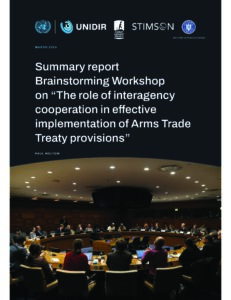Introduction
The Arms Trade Treaty (ATT) is the first legally binding instrument to regulate the global trade in conventional arms. The treaty was adopted by the UN General Assembly in April 2013 and entered into force in December 2014. The ATT establishes common standards for international arms transfers and establishes mandatory reporting mechanisms with the aim of:
- contributing to international and regional peace, security, and stability;
- reducing human suffering; and
- promoting cooperation, transparency, and responsibility in the international arms trade.
Eight years after the ATT’s entry into force, significant steps have been taken to fulfill the treaty’s obligations. One of the most quantifiable and easiest to measure metrics of treaty implementation is ATT reporting.
The ATT requires States Parties to submit two reports to the ATT Secretariat:
- First, States Parties are required to submit an initial report on treaty implementation that provides details on national laws and measures regulating arms transfers. States Parties are required to update this report should they make changes to their national arms transfer control systems. Initial reports are due within the first year of the ATT’s entry into force for that State Party. Accordingly, initial reporting deadlines vary; the first 53 States Parties to the ATT were required to submit their initial reports by 23 December 2015, while the ATT’s most recent State Party (the Philippines) has until 21 June 2023 to do so.
- Second, States Parties are obliged to submit annual reports on authorized or actual arms exports and imports that occurred during the previous calendar year. These reports are due by 31 May each year. In practice, however, the ATT Secretariat extends a seven-day grace period for the submission of annual reports, creating a de facto annual reporting deadline of 7 June each year. The first annual reports were due 31 May 2016 and cover the 2015 calendar year.
Comprehensive and consistent ATT reporting has a number of important and tangible benefits for States, the ATT Secretariat, civil society researchers, and other stakeholders, including:
- Indicating how States Parties interpret and implement the treaty’s obligations;
- Providing an opportunity for reporting States Parties to assess their national control systems, identify gaps, and make adjustments as needed;
- Helping to identify good practices and offering insights into common definitions and patterns in control measures;
- Shining a light on assistance needs to advance treaty implementation and States Parties that might be in a position to provide such assistance;
- Capturing treaty compliance and helping to determine the extent to which the treaty is meeting its potential in strengthening arms transfer regulations, improving transparency, and ultimately mitigating harm;
- Enhancing awareness of regional and global arms flows;
- Facilitating assessments of treaty compliance, particularly related to
- export and import decisions;
- Supporting efforts to monitor whether weapons use complies with international human rights and humanitarian law;
- Providing a baseline of ATT implementation measures that can be used to evaluate subsequent developments in national control systems, outline paths to compliance, and provide other States with blueprints for reform;
- Providing a baseline of legally transferred arms that can be used to identify illicit arms and their potential sources;
- Contributing towards the detection of early warning signs of potential conflict, such as potentially destabilizing weapons accumulations;
- Providing a basis for bilateral or multilateral consultations on transfers that may not align with ATT obligations; and
- Promoting transparency and building confidence among States involved in the global arms trade.
These benefits are not necessarily unique to ATT reporting. Other conventional arms-related reporting mechanisms were already in existence at the time of the ATT’s adoption in 2013, and reports submitted under these frameworks can also provide important insights into conventional arms transfers and national transfer control systems. The UN Register of Conventional Arms (UNROCA), which was established in 1991, invites States to submit voluntary annual reports on their arms exports and imports. States are also invited to share information on their national small arms and light weapons (SALW) control measures in voluntary reports submitted every two years under the UN Programme of Action on Small Arms and Light Weapons (PoA), which was established in 2001.
However, unlike the UNROCA and PoA, reporting under the ATT is mandatory. As the first and only international instrument to legally require States Parties to report on their arms transfers and transfer control systems, the treaty is uniquely well-positioned to advance arms trade transparency in ways these pre-existing transparency frameworks have not – including by increasing reporting levels and providing unique insights not captured in other reports.
But is the treaty living up to its potential? As we approach the 10th anniversary of the ATT’s adoption, we can take stock of progress made in implementing the treaty and in particular its reporting obligations. This report provides reflections on the trends, challenges, gaps, good practices, and lessons learned from the first seven years of ATT reporting – and in doing so, highlights the lack of universal compliance, increases in private reporting, and transparency issues that threaten to undermine the treaty’s potential. The report assesses the extent to which the ATT has meaningfully advanced transparency in the global arms trade and offers a roadmap for enhancing reporting efforts in the years ahead. This report is the fourth in Stimson’s ATT-Baseline Assessment Project series that takes stock of reporting under the treaty.1 This report is organized into four sections. Part one examines key trends that have emerged over the first seven years of reporting under the ATT. Part two provides insights into ATT reporting methods, experiences, and challenges drawn from survey research and interviews with States Parties. In part three, these reporting trends and insights are incorporated into analysis of the ATT’s overall impact on arms trade transparency. Finally, part four offers recommendations for the ATT Working Group on Transparency and Reporting (WGTR), Secretariat, and States Parties to strengthen reporting under the treaty.




